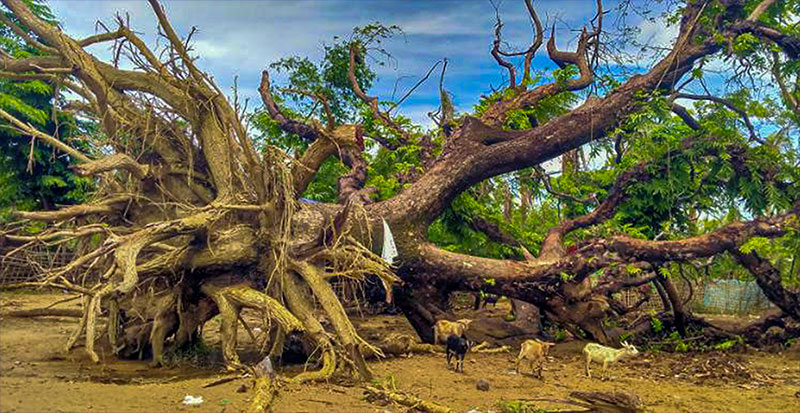- Ramree residents call on ULA to restore internet amid isolation
- Junta battalions fortify Kyaukphyu as fighting escalates
- Regime launches offensives against AA-held areas in Laymyethna Twsp
- Regime restricts patients returning from Yangon from carrying medicines to Arakan State
- Myanmar regime detains 220 Muslims at Sittwe Prison
Remembering the Fallen: Cyclone Mocha’s Toll on Trees
The storm also uprooted hundreds of perennial trees in both urban and rural parts of Ponnagyun, Kyauktaw, Rathedaung, Buthidaung, Maungdaw, Mrauk-U, Pauktaw and Myebon townships. Many of the trees were at least 40 years old, and some were older than 100 years.
21 Aug 2023

Written By Htet Aung
An enormous, uprooted lebbeck tree lay sprawled on a road near the entrance to Palinpyin Village, with its sizable root system exposed in testament to the force of the winds that took it down. The leaves were still green, but they had ceased to serve the important shade-providing function that this tree had been relied upon for decades.
The tree, which is nearly a century old, was blown down by Cyclone Mocha more than two months ago. It can no longer provide villagers with shade as it did before the storm, lamented U Maung Myaw Sein, the administrator of Palinpyin Village in Arakan State’s Sittwe Township.
“I feel sorry for the tree. It was the place where we gathered to chat on hot days. It is one of the oldest trees in our village,” he said.
Palinpyin is located some 12 miles to the northwest of the Arakan State capital Sittwe, with a population of 679 people across 140 households. The village has only two perennially shady trees, and both were blown down by the storm on May 14. The other was a 40-year-old giant crepe myrtle, known locally as a Khamaung tree.
Cyclone Mocha, which originated over the Bay of Bengal and made landfall near Sittwe, damaged or destroyed tens of thousands of buildings and felled trees large and small, clocking wind speeds up to 147 miles per hour.
The storm also uprooted hundreds of perennial trees in both urban and rural parts of Ponnagyun, Kyauktaw, Rathedaung, Buthidaung, Maungdaw, Mrauk-U, Pauktaw and Myebon townships. Many of the trees were at least 40 years old, and some were older than 100 years.
Some 200 teak trees were blown down in a teak forest of about 600 trees at the foot of the Mayu mountains in the east of Cheinkalein Village, located on the Agnumaw-Maungdaw road near the Bay of Bengal.
“We feel sad that trees that we have spent nearly 20 years taking care of were blown down,” said U Tun Tin Soe, a resident of Cheinkalein Village who owns the teak forest.
Sixty years ago, Cheinkalein Village had many perennially shady trees, like lebbeck and tamarind. But nearly all of them were blown down during a storm in 1968, and in the months and years thereafter, no concerted effort was made to replace them. Though most Cheinkalein Village residents are too young to remember that storm, the lack of a coordinated replanting campaign then offers lessons for today.
Villagers may not immediately notice the impacts of the trees that they have lost, but there will be consequences in the long run, warned U Tun Kyi Maung, the administrator of Pyaing Chaung Village in Kyauktaw Township.
“We have lost shady places for the hot season. We have plans to plant trees in the place of fallen trees. However, we have not yet received trees to plant. And it will take many years until they grow big,” said U Tun Kyi Maung.
A woman from the MyoU IDP camp in downtown Rathedaung said that after the storm flattened trees there, residents of the camp were more affected by the heat.
“It is no longer the same as before in the displacement camp and there is no place for us to stay when it is hot. … There was nothing left of the mangoes because of the storm,” she added.
Trees, of course, serve a dual function when it comes to beating the heat: Their shade-giving properties are coupled with the photosynthetic process, by which they remove carbon dioxide — the greenhouse gas most responsible for global warming — from the atmosphere. Thus a large-scale loss of trees, as occured in Arakan State due to Cyclone Mocha, has both local and planetary impacts.
April is historically the hottest month of the year in Arakan State. In 2020, the average temperature in the state capital Sittwe was 33.3 degrees Celsius, while this year it was 34.6 degrees Celsius, making 2023 the hottest April on record, according to the Department of Meteorology and Hydrology (DMH).
“Since Cyclone Mocha destroyed many trees, trees need to be planted in a timely fashion,” said U Hla Tun, director of the Arakan State DMH. “If the trees are not planted in time, it is possible that temperatures will increase in the years to come.”
Environmentalists point out that the loss of tree cover also has consequences for the birds, monkeys and other animals that call the forests their home. Some ecosystems, already in a fragile state due to climate change and other anthropogenic changes, may struggle to recover from Cyclone Mocha’s destruction.
Environmental advocates say the relevant authorities in Arakan State must undertake a vigorous replanting campaign in the villages and forests where Cyclone Mocha and other past natural disasters have taken a heavy toll on tree populations.
After Cyclone Mocha struck, the Arakan Army (AA) and its political wing, the United League of Arakan (ULA), worked to plant trees during the rainy season.
“Since the ULA/AA can control both the mountain areas and the coastal areas in Arakan State, we would like to establish a policy and systematically plant trees,” said Ko Myo Lwin, an environmentalist. “If we can do that, we can build a movement.
“We intend to plant trees in the villages where there are big fallen trees,” said Ko Tun Aye Hlaing, president of the Rathedaung Development Association, which is helping to clean up the downed trees. “But there will be some road travel difficulties, so there will be a little delay.”




.jpg)















